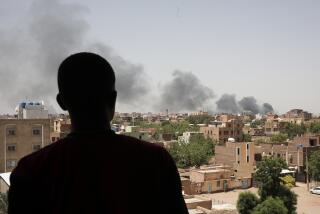U.S. Troops Authorized to Disarm Somali Bandits : Mandate: They also may help set up bounty system to buy weapons they cannot seize, Pentagon says.
- Share via
WASHINGTON — American forces will have the authority to disarm Somali bandits they encounter in the countryside, and they may help establish a bounty system to buy weapons that troops cannot seize, Pentagon officials said Friday.
Defense Secretary Dick Cheney and Joint Chiefs Chairman Colin L. Powell acknowledged that the United States’ toughest challenge in Somalia may be preventing the heavily armed marauders from taking over again after the troops leave.
But by buying or taking as many weapons as they can, then leaving a residual force off the Somali coast for a time after U.S. forces withdraw, Pentagon officials said they hope to sustain the now-launched, extraordinary American pacification effort.
One knowledgeable State Department official, however, expressed doubts that the weapons bounty would be effective, because of the vast number of weapons and their wide distribution in Somalia. “If I were a bad guy there, I would love the proposal, because I would sell two or three of my weapons and keep the rest,” the official said.
Disarming the Somali population, at least to manageable levels, is likely to be a decisive factor in whether the international venture is judged a success or a failure.
Many young Somali males have bazooka rockets and machine guns looted from once-rich weapons repositories. If the weapons remain in their hands, the resulting violence could not only delay the withdrawal of American combat troops but threaten plans to bring in United Nations troops as peacekeepers.
“If it were simply a question of all of the forces that are there today going underground . . . for a couple of months and then being in a position to pop up again once we leave, that probably would not be sufficient,” Cheney said Friday.
Powell said troops have been directed to take “preemptive action” to seize bandits’ arms and to “create a set of circumstances” in which relief aid can move freely throughout the country. “It’s sort of like the cavalry coming to the rescue, straightening things out for a while and then letting the marshals come back in to keep things under control,” he said.
In an apparent effort to signal resolve to Somali gunmen, Powell and Cheney broke with longstanding Pentagon practice and publicly discussed the guidelines under which American troops will operate.
“We’re just not going to ride shotgun, waiting for people to shoot at us and then shoot back,” Powell said. “If we see areas where it will be dangerous for our troops to operate without doing something about the cause of the danger beforehand, we’ll do what’s necessary to eliminate the danger.”
Powell and other senior Pentagon officials said the Bush Administration and the United Nations are discussing a system of arms collection in which money or food would be paid to those who turn in weapons. One official called the proposal a “lemonade stand,” with bandits, once deprived of their power over food supplies, willing to relinquish weapons willingly.
Powell suggested that the State Department and its Agency for International Development could have a role in setting up such a system.
Even Powell acknowledged the limits of attempts to disarm the thugs. Despite the American military’s efforts, U.N. peacekeeping forces arriving in January will still face the prospect of random deadly violence, he said.
“There will always be a level of lawlessness in Somalia,” Powell said. “There are guns all over the country, so there should be no expectation that . . . our effort, even if we were to triple that effort, and the effort of a very large U.N. peacekeeping force would be successful in removing every AK-47 in Somalia.”
Indeed, even as American leaders were announcing their humanitarian plans, there were reports of a shootout between Pakistani U.N. peacekeepers and Somali gunmen near the Mogadishu airport; one Somali was killed in the incident.
Disarming the Somalis will be only one of many obstacles now facing “Operation Restore Hope.” Others are the 7,500-mile distance of the undertaking and the complete absence of public works, from water supplies to fuel to full-length airstrips, needed to open roads to relief supplies. Officials said the airlift will likely become a major challenge for American planners because of the terrible conditions at the Mogadishu and other Somali airports.
The Mogadishu airfield, battered and stripped by gun-toting bandits, has no fuel and can accommodate no more than two of the Air Force’s larger cargo planes at a time. And none of the four airfields that are intended to become distribution centers in the interior regions can accommodate the Air Force’s large C-141 or C-5 transport aircraft. That will require the complex unloading and reloading of cargo onto helicopters and smaller C-130 aircraft.
“Logistically, it is enormously challenging,” Powell said Friday of the Somali operation. “When you say to somebody, ‘Take 28,000 troops and send them 7,500 miles or so away, and by the way, there’s no potable water there, and there are no gas stations and there’s only one or perhaps two C-141-capable airfields and the port facilities only hold one or two ships,’ that is very demanding.”
Powell told lawmakers earlier that those difficulties will make the deployment longer than has been reported. Casting doubt on White House predictions that American troops could be in and out of Somalia by Inauguration Day, Jan. 20, Powell said it would be two to three months before the bulk of U.S. forces are withdrawn. At that point, Powell, added, a “posse” of several thousand Marines could wait offshore for orders to go in and restore order if chaos threatens to break out anew.
More to Read
Sign up for Essential California
The most important California stories and recommendations in your inbox every morning.
You may occasionally receive promotional content from the Los Angeles Times.













